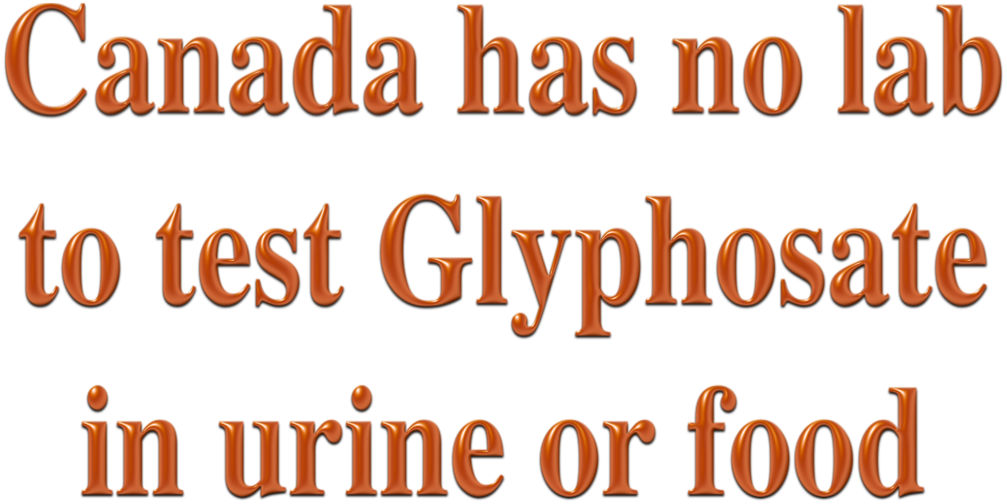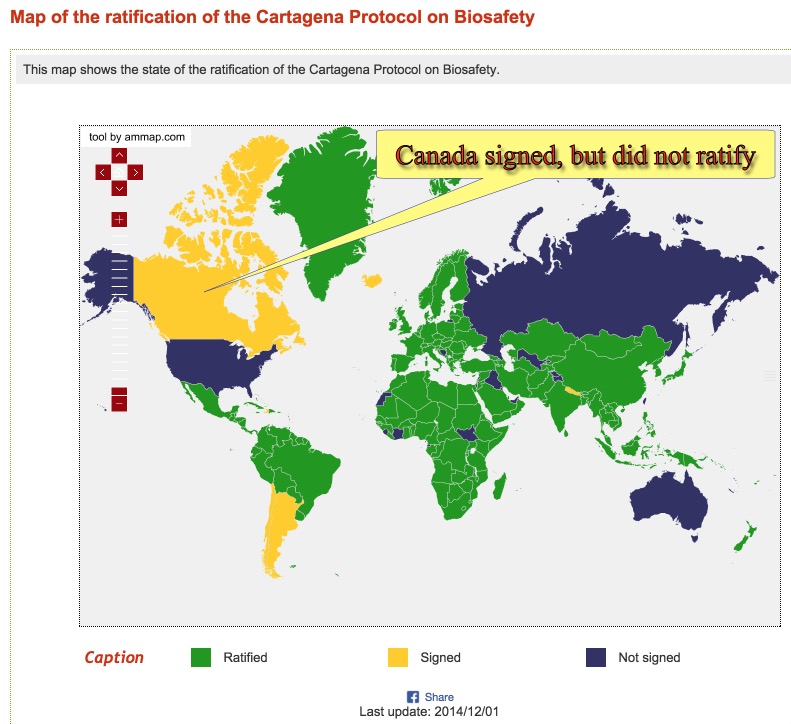Glyphosate is the poison in Monsanto’s RoundUp herbicide, the most used weed killer in Canada. It is used on RoundUp ready GM crops, and also as desiccant on non GM crops. it is to be used on prairies with designed GM alfalfa. It is being sprayed from the air on Canadian forests by logging companies. It is everywhere.
There is a rising body of study that point to possible link between our exposure to this chemical and an unparalleled rise of various chronic diseases in North America.
Here in Canada, there is no lab that will test citizen’s urine, or blood, or breast milk of nursing mothers, for traces of Glyphosate. There is no lab in Canada where one can test the food we buy in our store, for presence of Glyphosate.
Are there such labs available in other regions ? Yes, USA has them. There are labs in the rest of the world, but not in Canada.
Why are there no labs in Canada ? Because no doctor, no hospital, no environment ministry or health ministry is asking for routine and broad range testing of Canadian people and Canadian food, for glyphosate poisoning. Labs are commercial ventures. They will provide a service only if there is sufficient demand.
 So, here is an appeal for all Canadians – join us and create a demand. All you need to do is ask your doctor, or hospital, or clinic, to arrange for a test of urine, or blood, or breast milk for nursing mothers, as well as a few heavily used food brand for your family such as a brand of milk, or bread, or meat. If enough doctors or hospitals started asking around for this test, this would generate a demand, and some labs would respond to it and start offering this service. Right now, a few Canadian labs offer the service of testing Glyphosate in water, and soil. Unfortunately, they will not test it in your food, or your body fluids as of now.
So, here is an appeal for all Canadians – join us and create a demand. All you need to do is ask your doctor, or hospital, or clinic, to arrange for a test of urine, or blood, or breast milk for nursing mothers, as well as a few heavily used food brand for your family such as a brand of milk, or bread, or meat. If enough doctors or hospitals started asking around for this test, this would generate a demand, and some labs would respond to it and start offering this service. Right now, a few Canadian labs offer the service of testing Glyphosate in water, and soil. Unfortunately, they will not test it in your food, or your body fluids as of now.
For those that wish to learn more about what Glyphosate is, and why it should be a matter for concern – read the bottom section of this blog, where a copy of a letter recently written by retired Canadian genetic engineer Dr. Thierry Vrain to the health minister is included, covering this very subject, with scientific references to international studies. You can also check my own blog from the summer, where I asked for a nationwide testing for Glyphosate, and how our efforts are delayed due to the roadblock of not having any lab in Canada, and sending samples overseas or across the border is proving difficult and costly.
I am also including another external link : The microbiota Crisis and how Glyphosate is killing animal micro biome, including our own, and how this micro biome is vital for all us in the animal kingdom.

Above is a sample letter. Use it if you like, or modify it as needed. Wording of the same blank letter is shown below. Do not offer to pay for the tests as of now. Idea is for doctors and hospitals to start enquiring about testing Glyphosate in food and in people. If enough demand is perceived, some labs will start offering this service.
We intend to self-label our food
Idea is for us to contribute in testing our food. I could pay for testing one or two brand of food, apart from my own urine etc. Someone else would test another food item. We shall keep loading the findings on the internet in a sort of nationwide list. Eventually, with hundreds of citizens pulling in, we shall have hundreds of food items tested and self-labelled, so to speak, for the rest of the nation to check on. Then, for those that do not like to have Glyphosate in their food, or those that already find Glyphosate within themselves and are looking to identify and exclude those food items from where it might be intruding from, they can then start automatically banning those food items that are tested with high Glyphosate content. This self-driven citizens action bypasses the entire political circus of trying to convince Ottawa politicians to pay heed to public concerns, an exercise so far proving to be very difficult thanks to the financial clout of the foreign corporations that peddle the toxic stuff onto us.
That is one reason we need a lab. Besides, Canada is not a fourth world country – or we hope not. The first, the second and the third world already have labs for testing Glyphosate. It is a national shame that Canada has none.
So, please help Canada in helping ourselves on this important task.
The plan is not just to get a lab. A lab is the first step, which we should not even have had to deal with, had our Govt been careful. The Govt has not been so, and we now have to work extra for the first part – of getting a lab.
Once we have the lab, Canadians can then do into a citizen-driven self labelling drive. I would test a few food products myself, out of my own pocket if need be. If two hundred Canadians from coast to coast, decided to test one food item each, apart from testing ourselves, then Canada would have two hundred food items tested. Results would be put up on the internet, for the rest of 35 million Canadians to check up on, and decide what to buy and what not to. We can do this without asking Ottawa politicians for anything.
Citizens can, and in this case, may have to, take care of our health and environment issues on our own, since the Govt seems to have abandoned the cause. Citizens will label the food. Citizens will selectively ban the food according to label and need.
Thats the plan.
Sample letter 1
To : Doctor, or Nurse, or Hospital etc
From : Your name
Date :
I am concerned that my corn, soy or wheat based food may contain traces of a herbicide called glyphosate. I would like to get my body fluids and possible fat tissue sample tested for the presense of glyphosate to see if I am accumilating any of it in my body.
If I supply you with the samples, can you please arrange to get them tested?
I would prefer for the results of the tests to be sent to me personally, as well as to your office.
Samples I wish to test: Urine (2 samples), blood(1 sample), milk (1), bread(1), cooking oil(1) – (Please modify this letter and the list of items you wish to test, to suit your situation).
Appreciate your prompt action in this.
Thanking you,
Name & address
Sample letter 2
To : Doctor, or Nurse, or Hospital etc
From : Your name
Date :
I wish to test some samples for Glyphosate. Glyphosate is the active ingredient in Round-Up herbicide and is being liberally sprayed on much of my food, both GMO and non GMO. I am concerned that this Glyphosate is migrating into my body, and may adversely affect my health.
If I supply you with the samples, can you please arrange to get them tested?
I would prefer for the results of the tests to be sent to me personally, as well as to your office.
Samples I wish to test: Urine (2 samples), blood(1 sample), milk (1), bread(1), cooking oil(1) – (Please modify this letter and the list of items you wish to test, to suit your situation).
Appreciate your prompt action in this.
Thanking you,
Name & address
Note from a Canadian lab, about testing Glyphosate in urine and food
Hi Tony:
We will look into the method once there is a demand, we cannot allocate resources to the development of a method for which there is no market at the moment. Also it will be a non-accredited method at this point.
Thanks.
Dr. Thierry Vrain’s letter to Rona Ambrose, health minister
October 27, 2014
To the Honorable Rona Ambrose, Minister of Health
Re: herbicide pollution and GMO labeling
Minister,
The confusion about the safety of GMOs is quite simple to address. The only GMOs in our agriculture are Glyphosate Modified Organisms also known as RoundUp Ready crops and the only GMOs in our food supply are from those crops. RoundUp Ready crops are engineeredto be sprayed with the herbicide RoundUp and this technology has become so successful that RoundUp has become a major pollutant (1). This chemical pollution is antibiotic, it impacts the microbiome, impairs CYP enzymes, and depletes food of essential mineral micronutrients. As a background paper for the impact of this pollution I offer my speaking notes to the American College of Nutrition conference last week in San Diego (Texas). Most of the studies I cite were published in the last five years.
Glyphosate is the active ingredient of the herbicide RoundUp, a new molecule created in 1960 by Stauffer Chemicals – a US company with a business of cleaning industrial pipes and boilers of mineral scales. The mineral deposits (same as in electric kettles) are called scales, and the pipe cleaning chemicals are called desc aling agents. Glyphosate was patented in 1964 in the US as a powerful and very broad spectrum descaling agent (2). Meaning, it binds to metals indiscriminately and does a great job at “dissolving and preventing minerals from being reactive or bioavailable in solution”. When the descaling solution was disposed of in nature, it was obvious that it killed plants. The chemical company Monsanto promptly bought the molecule, patented it as a herbicide in 1969, and got it commercialized in 1974 (3).
aling agents. Glyphosate was patented in 1964 in the US as a powerful and very broad spectrum descaling agent (2). Meaning, it binds to metals indiscriminately and does a great job at “dissolving and preventing minerals from being reactive or bioavailable in solution”. When the descaling solution was disposed of in nature, it was obvious that it killed plants. The chemical company Monsanto promptly bought the molecule, patented it as a herbicide in 1969, and got it commercialized in 1974 (3).  This molecule is making history because glyphosate has become the most successful agricultural chemical in North and South America wherever RR seeds are used. The farmers using this technology get simpler and cheaper weed management and despite
This molecule is making history because glyphosate has become the most successful agricultural chemical in North and South America wherever RR seeds are used. The farmers using this technology get simpler and cheaper weed management and despite
higher input bills and sometimes disappointing yields, and with weed resistance spreading fast, they adopted it in troves (4).
The herbicide RoundUp had a completely novel chemistry for a herbicide in 1969. It was deemed to kill plants by bonding to only one protein enzyme in the chloroplasts – the same enzyme that is also in bacteria and fungi. Enzymes are metalloproteins with a metal atom as a cofactor at the active site of the molecule. Bacteria and plants and fungi have a metalloprotein called EPSPS for short and 5-Enol Pyruvyl Shikimate-3 Phosphate Synthase if you want to know what it does. It works with other metalloproteins to “make” several of the building blocks of proteins, the aromatic amino acids. These molecules are also building blocks for a large number of aromatic molecules we call secondary compounds. Glyphosate binds tightly to the manganese atom at the centre of the EPSPS metalloprotein, so tightly that the protein cannot move and do its work making aromatic amino acids. No protein synthesis means there is no metabolic work possible, a quick death for the plant, or the fungi or the bacteria.
Animals do not make their own aromatic amino acids since they lack the shikimate pathway with the EPSPS metalloprotein. Because of its presumed mode of killing plants, glyphosate was pronounced innocuous to humans and registered as such in 1974 in the USA. Glyphosate has no acute toxicity, and at the time of registration in the US, and even since, nobody has bothered to check for chronic effects beyond 3 months. Considering the chemical properties of this pollution one would expect long term chronic effects, very similar to rickets, scurvy, or beri beri, for lack of micronutrients. The Industry sponsored feeding studies proving the safety of GMOs do not include testing for the safety of glyphosate. None of them bother to mention the residue levels of glyphosate in the feed. Meanwhile, a fast growing series of independent studies in various countries published in the last 5 years have ascertained the impact of glyphosate on various cellular enzymes and organs of animals and human cells.
The first RoundUp Ready crops to be commercialized were soy and corn, released in 1996. Since then, a handful of RR crops have been adopted enthusiastically by farmers, particularly in North and South America. Today close to 500 million acres of soya and corn, and cotton, canola, and sugar beet, are engineered to be sprayed with RoundUp. About 40% of all RR crops are grown in the USA, most of the rest are grown in Brazil, Argentina, Canada, and a few other countries. RR crops are now sprayed with close to two billion lbs of glyphosate every year, and so much of that finds its way into processed food and feed that the EPA had to raise the legal residue limits last year to accommodate a new reality (5).
Glyphosate is antibiotic, a powerful and broad spectrum antibiotic (6). The mode of kill is again alleged to be very selective. The glyphosate molecule impairs the functioning of the shikimate pathway in bacteria the same way it does in plants. Only one enzyme is affected in a pathway that animals do not possess. The antibiotic patent describes its effectiveness to kill bacteria at 1 ppm and this was confirmed last year in Germany (7). At this point I usually spend a minute or two explaining why a low level antibiotic diet for the rest of your life is not a good idea. I describe the recent interest of the medical field in a large joint research project involving many Universities to decipher the huge community of thousands of species of bacteria that call us home. The Human Microbiome project is the equivalent of the Human Genome project in its scope. We are vastly outnumbered, roughly ten to one – one hundred trillion bacterial cells call our lower intestine home. They are forever sending signaling molecules to each other and to all human organs, particularly the brain. All animals depend on their symbiosis with these bacteria, and humans are no exception.
They are the teachers of our immune system, they make many neurotransmitters for our brain, and have a strong connection to the heart and the whole digestive tract. They literally feed us all kinds of molecules that we require – we call them essential, like vitamins and such. They digest and recycle most of our food. Most human organs rely on molecular signals from the microbiome for normal functioning. As goes the microbiome, so does its human shell. A recent review of the medical literature on celiac and other diseases shows the link to imbalances of the microbiome that are fully explained by the antibiotic properties of glyphosate (8). And the same authors published another review of the impact of glyphosate on the CYP enzymes and the microbiome. Samsel and Seneff have suggested that glyphosate’s suppression of CYP enzymes and its antibiotic effect on the human microbiome are involved in the etiology of many chronic degenerative and inflammatory diseases that have grown to epidemic proportions since 1996, since the advent of the RoundUp Ready technology (10).
We lack any official data on residues of glyphosate in food or in water in Canada – no epidemiological studies of any kind have ever been done. All we have are the legal maximum residue limits now allowed by the EPA in RoundUp Ready foods, human cereal 30 ppm, animal grain 100 ppm, soybean 120 ppm, and everything else in between (5). Here an inquisitive mind will ask why there is such a high residue limit for cereal when none of the grains are engineered to be sprayed with RoundUp. This is when you learn that RoundUp is sprayed on many non-engineered crops with the intent to kill them right before harvest. This is done to mature and dry the crops quickly to make them easier and cheaper to harvest. The RoundUp herbicide has now become a dessicant.
There is direct toxicity to animal cells because glyphosate binds to metals indiscriminately, and not just in plant cells. It binds to metals in solution and to metal co-factors at the centre of metalloproteins anywhere. For example glyphosate binds to the iron atom at the centre of a large family of protein enzymes called CYP. There are 57 different CYP enzymes in the human body, and approximately 20,000 in animals, plants, bacteria and fungi. The CYP enzymes are oxydizers, the first line of digestion and detoxification of most substrates. David Nelson wrote in a review of the CYP enzymes: “The CYP enzymes of humans are essential for our normal physiology and failure of some of these enzymes results in serious illnesses (9,10).
Nancy Swanson has made public her statistical analyses of the US Centre for Disease Control’s statistics about the health status of America when placed next to the statistics of the US Department of Agriculture about the spread of RoundUp Ready soy and corn. Her correlation analyses show very high coefficient values suggesting strong links between glyphosate residues in RoundUp Ready food and chronic illnesses (11).
Medical and chemical reviews and peer reviewed studies have explained the mode of action of glyphosate and its impact on many metalloproteins. Human cell studies have shown acute toxicity (12-15) and animal studies have shown chronic toxicity (16-21). Glyphosate bioaccumulates in the plants and in any animal that eat the plants.
Glyphosate accumulates in the lungs, the heart, kidneys, intestine, liver, spleen, muscles, and bones … and chronically ill people have higher residues in their urine than healthy people.”(22)
To conclude this presentation of the nutritional status of Glyphosate Modified Organisms, I would say that crops sprayed with RoundUp, whether they are RoundUp Ready or not, contain residues of glyphosate, that foods made from RoundUp Ready soy and corn and sugar and canola, etc … are depleted of the minerals that are bound to the glyphosate molecules (23). Foods made from crops containing residues of glyphosate are by definition depleted of minerals and toxic.
Minister, your reassuring words have been quoted widely. “Currently, there is no… scientific evidence, that says genetically modified foods are unhealthy. It is impossible for us to mandate a label, because our labels have to be based on evidence that it is an unhealthy product for Canadians.” I hope you have found here the scientific evidence you require to act and that you join over 60 governments in the world who have found this evidence compelling enough in the past few years, to legislate some form of labeling or ban RoundUp Ready crops and the herbicide RoundUp.
Respectfully,
Dr. Thierry Vrain
Literature cited
- Battaglin W.A., Meyer M.T., Kuivila K.M., Dietze J.E. 2014. Glyphosate and its degradation product AMPA occur frequently and widely in US soils, surface water, groundwater, and precipitation. J. Amer. Water Res. Assoc. 50, 275-290.
- U.S. Patent 3,160,632 Stauffer Chemicals 1964
- US Patent 3,455,675 Monsanto Chemicals 1969
- Fernandez-Cornejo J., Wechsler S.J., Livingston M. and Mitchell L. 2014. Genetically Engineered crops in the United States. USDA Economic Research Report No. (ERR-162) 60 pp. http://www.ers.usda.gov/media/1282246/err162.pdf
- EPA 2013 MCL (US Environment Protection Agency legal Maximum Contaminant Levels).
- U.S. Patent Number 7,771,736 Monsanto Chemicals 2010.
- Shehata, A.A., Schrödl, W., Aldin, A.A., Hafez, H.M. and Krüger, M. 2013. The effect of Glyphosate on potential pathogens and beneficial members of poultry microbiota. Curr. Microbiol. 66:350-358.
- Samsel, A. and Seneff, S. 2013. Glyphosate, pathways to modern diseases II. Celiac sprue and gluten intolerance. Interdiscip. Toxicol. 6: 159-184
- Nelson, D. 2013. A world of cytochrome P450s. Philo. Transac. Royal Soc. London B 368 No 1612.
- Samsel, A. and Seneff, S. 2013. Glyphosate’s suppression of cytochrome P450 enzymes and amino acid biosynthesis by the gut microbiome: pathways to modern diseases. Entropy 15: 1416-1463.
- Nancy Swanson – Seattle GMO examiner.
- Gasnier, C., Dumont, C., Benachour, N., Clair, E., Chagnon, M.C. and Séralini, G.E. 2009. Glyphosate-based herbicides are toxic and endocrine disruptors in human cell lines. Toxicology 262: 184-191.
- Benachour N. and Seralini, G.E. 2009. Glyphosate induces apoptosis in human umbilical, embryonic, and placental cells. Chem. Res. Toxicol. 22: 97-105.
- Koller, V.G., Fürhacker, M., Nersesyan, A., Mišík, M., Eisenbauer, M. and Knasmueller, S. 2012. Cytotoxic and DNA-damaging properties of glyphosate and Roundup in human-derived buccal epithelial cells. Arch. Toxicol. 86: 805-813.
- Thongprakaisang, S., Thiantanawat, A., Rangkadilok, N., Suriyo, T. and Satayavivad, J. 2013. Glyphosate induces human breast cancer cell growth via estrogen receptors. Food Chem. Toxicol. 59: 129-136.
- Senapati ,T., Mukerjee, A.K. and Ghosh, A.R. 2009. Observations on the effect of glyphosate based herbicide on ultrastructure (SEM) and enzymatic activity in different regions of alimentary canal and gill of Channa punctatus (Bloch). J. Crop Weed 5: 236-245.
- Paganelli, A., Gnazzo, V., Acosta, H., López, S.L. and Carrasco, A.E. 2010. Glyphosate herbicides produce teratogenic effects on vertebrates by impairing retinoic acid signaling. Chem. Res. Toxicol. 23: 1586-1595.
- Vecchio, L., Cisterna, B., Malatesta, M., Martin, T.E. and Biggiogera, M. 2004. Ultrastructural analysis of testes from mice fed on genetically modified soybean. Eur. J. Histochem. 48:448-454.
- El-Shamei, Z.S.; Gab-Alla, A.A.; Shatta, A.A.; Moussa, E.A.; Rayan, A.M. 2012. Histopathological changes in some organs of male rats fed on genetically modified corn. J. Am. Sci. 8: 684-696.
- Séralini, G.E., Clair, E., Mesnage, R., Gress, S., Defarge, N., Malatesta, M., Hennequin, D. and de Vendômois, J.S. 2014. Republished study: Long-term toxicity of a Roundup herbicide and a Roundup-tolerant genetically modified maize. Environ. Sci. Eur. 26:14
- Clair. E, Mesnage, R., Travert, C. and Séralini, G.É. 2012. A glyphosate-based herbicide induces necrosis and apoptosis in mature rat testicular cells in vitro, and testosterone decrease at lower levels. Toxicol. in Vitro 26: 269-279.
- Kruger, M., Schledorn, P., Schrodl, W., Hoppe, H.W., Lutz, W. and Shehata, A.A. 2014. Detection of glyphosate residues in animals and humans. Environ. & Anal. Toxicol. 4:2
- Zobiole, L.H., Kremer, R.J., de Oliveira, R.S. and Constantin, J. 2012. Glyphosate effects on photosynthesis, nutrient accumulation, and nodulation in glyphosate-resistant soybean. J. Plant Nutri. Soil Sci. 175: 319



 This is a welcome start of the section. It describes where Canada is with regard to how our food supply is being degraded by unhealthy, unhygienic and potentially toxic ingredients, not to mention the potential loss of our biodiversity through theft or contamination from patent holding foreign corporations that aim to own any living organism that one could make money on. Based on such statements, I expect the Green party policy to lay down action items that its candidates would initiate, to redress our agriculture, food security, and ecology.
This is a welcome start of the section. It describes where Canada is with regard to how our food supply is being degraded by unhealthy, unhygienic and potentially toxic ingredients, not to mention the potential loss of our biodiversity through theft or contamination from patent holding foreign corporations that aim to own any living organism that one could make money on. Based on such statements, I expect the Green party policy to lay down action items that its candidates would initiate, to redress our agriculture, food security, and ecology.
